| |
|
Xiamen Oil Paintings, Wholesale Direct!
|
|
100% hand painted, 100% cotton canvas, 100% money back if not satisfaction. |
|
|
|
|
ART WORKS INDEX
A
B
C
D
E
F
G
H
I
J
K
L
M
N
O
P
Q
R
S
T
U
V
W
X
Y
Z
|
|
ARTISTS INDEX
A
B
C
D
E
F
G
H
I
J
K
L
M
N
O
P
Q
R
S
T
U
V
W
X
Y
Z
|
|
|
|
|
|
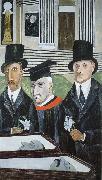 |
Xie An
|
|
Xie An (320-385), courtesy name Anshi .formally Duke Wenjing of Luling , was a Jin Dynasty (265-420) statesman who, despite his lack of military ability, led Jin through a major crisis -- attacks by Former Qin. His line became one of the two most honored during the subsequent Southern Dynasties -- the other being Wang Dao's line -- and in the minds of the people no less honored than imperial clans.
|
|
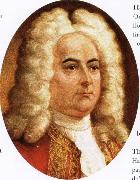 |
wolfgang amadeus mozart
|
|
Born: 27 January 1756
Birthplace: Salzburg, Austria
Died: 5 December 1791 (fever)
Best Known As: Composer of Eine kleine Nachtmusik
|
|
|
|
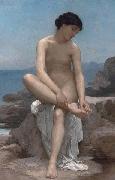 |
William-Adolphe Bouguereau
|
|
(November 30, 1825 - August 19, 1905) was a French academic painter. William Bouguereau was a traditionalist whose realistic genre paintings and mythological themes were modern interpretations of Classical subjects with a heavy emphasis on the female human body.
William-Adolphe Bouguereau was born in La Rochelle, France on November 30, 1825, into a family of wine and olive oil merchants. He seemed destined to join the family business but for the intervention of his uncle Eugene, a Roman Catholic priest, who taught him classical and Biblical subjects, and arranged for Bouguereau to go to high school. Bouguereau showed artistic talent early on and his father was convinced by a client to send him to the École des Beaux-Arts in Bordeaux, where he won first prize in figure painting for a depiction of Saint Roch. To earn extra money, he designed labels for jams and preserves
|
|
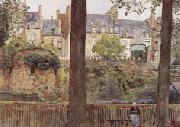 |
William Frederick Yeames,RA
|
|
1835-1918
English painter. The son of a British consul in Russia, Yeames was sent to school in Dresden after the death of his father in 1842. He also studied painting there. The collapse of the Yeames family fortune resulted in a move to London in 1848, where Yeames learnt anatomy and composition from George Scharf (1788-1860). He later took lessons from F. A. Westmacott. In 1852 he continued his artistic education in Florence under Enrico Pollastrini and Raphael Buonajuto, from whom he learnt the methods of the Old Masters. He drew from frescoes by Ghirlandaio, Gozzoli and Andrea del Sarto and painted in the Life School at the Grand Ducal Academy. He then went to Rome and made landscape studies and copied Old Masters, including Raphael's frescoes in the Vatican. His extensive study of Italian art gave him a precision and facility that assisted his artistic success upon his return to London in 1859. There he set up a studio in Park Place and became involved with the ST JOHN'S WOOD CLIQUE. He exhibited at the Royal Academy and the British Institution from 1859 and became an ARA in 1866.
|
|
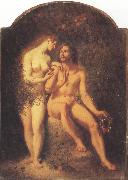 |
William Edward frost R.A.
|
|
1810-1877
was an English painter of the Victorian era. Virtually alone among English artists in the middle Victorian period, he devoted his practice to the portrayal of the female nude. Frost was educated in the schools of the Royal Academy, beginning in 1829; he established a reputation as a portrait painter before branching into historical and mythological subjects, including the sub-genre of fairy painting that was characteristic of Victorian art. In 1839 he won the Royal Academy's gold medal for his "Prometheus Bound," and in 1843 he won a prize in the Westminster Hall competition for his "Una Alarmed by Fauns" (a subject from Spenser's The Faerie Queen). He was elected an associate member of the Royal Academy in 1846, and a full member in 1870. Frost is widely recognized as a follower of William Etty, who preceded him as the primary British painter of nudes in the second quarter of the nineteenth century.
|
|
|
|
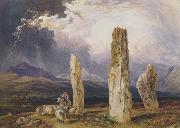 |
William Andrews Nesfield
|
|
British Painter, 1793-1881
was born in Lumley Park, County Durham. In 1808, after the death of William's mother, the family moved the few miles to Brancepeth where his father became rector of St Brandon's Church. His stepmother was Marianne Mills of Willington Hall, whose nephew was the noted architect Anthony Salvin. William's younger sister in fact married Salvin. Nesfield was educated at Durham School, then located on Palace Green, before entering the army. He fought under Wellington in Spain and at Waterloo and also served for two years in Canada. He retired in 1816 and took up a career as a painter of watercolours, particularly of waterfalls, earning the praise of John Ruskin in Modern Painters. While still exhibiting at the Old Water Colour Society, Nesfield began work as a professional landscape architect, with the encouragement of Salvin. From 1840 until his death he was responsible, either singly or with his sons Arthur Markham and William Eden for no fewer than 259 commissions in the British Isles.
|
|
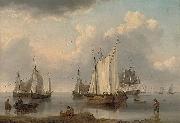 |
William Anderson
|
|
William Anderson (1757 - 27 May 1837) was born in Scotland and became an artist specializing in maritime and patriotic themes..
Anderson's training as a shipwright stood him in good stead when he became an artist specializing in maritime art based on the Dutch 17th century Masters. He first exhibited at the Royal Academy in 1780 and continued to exhibit annually until 1811. He then exhibited intermittently until 1834. His best work was executed in the years 1790-1810, during the French Revolutionary and Napoleonic Wars, at which time the demand for naval paintings was high. He painting was not restricted to marine subjects.
His pictures, shown at exhibitions, include A View of Berwick-on-Tweed and A View of Tynemouth. His history paintings include The Battle of Waterloo, The Capture of Fort Louis, Martinique, 1794, which shows the attack by Commander Robert Faulknor of Zebra on Fort Saint Louis (Martinique), The Battle of Cape Finisterre, The First Battle of Groix and The Battle of the Nile . Other paintings include Shipping on the Thames at Deptford and View at the mouth of the Thames ..
|
|
|
|
 |
William Alexander Coulter
|
|
(March 7, 1849 - March 13, 1936) was an American painter of marine subjects. Coulter was a native of Glenariff, County Antrim, in what is today Northern Ireland. He became an apprentice seaman at the age of 13, and after seven years at sea, came to settle in San Francisco in 1869. In the late 1870s, he went to Europe to study with marine artists Vilhelm Melbye, François Etienne Musin, and J. C. Jacobsen. In 1896, he joined the art staff of the San Francisco Call. Between 1909 and 1920, he painted five 16 by 18 foot murals for the Assembly Room of the Merchants Exchange Building. Coulter resided in the San Francisco Bay Area until his death at the age of 87, in his Sausalito home. During the course of his life, his paintings chronicled the history of shipping and navigation in the San Francisco and San Pablo bays.
|
|
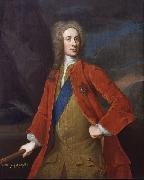 |
William Aikman
|
|
William Aikman (24 October 1682 - 7 June 1731) was a Scottish portrait-painter.
Aikman was the son of William Aikman, of Cairney. His father intended that he should follow the law, and gave him an education suitable to these views; but the strong predilection of the son to the fine arts induced him to attach himself to painting alone. Poetry, painting, and music have, with justice, been called sister arts. Mr. Aikman was fond of poetry; and was particularly delighted with those unforced strains which, proceeding from the heart, are calculated to touch the congenial feelings of sympathetic minds. It was this propensity that attached him so warmly to Allan Ramsay, the Doric bard of Scotland. Though younger than Ramsay, Mr. Aikman, while at college, formed an intimate acquaintance with him, which constituted a principal part of his happiness at that time, and of which he always bore the tenderest recollection. It was the same delicate bias of mind which at a future period of his life attached him so warmly to Thomson, who then unknown, and unprotected, stood in need of, and obtained the warmest patronage of Aikman; who perhaps considered it as one of the most fortunate occurrences in his life that he had it in his power to introduce this young poet of nature to Sir Robert Walpole, who wished to be reckoned the patron of genius, and to Arbuthnot, Swift, Pope, Gay, and the other beaux esprits of that brilliant period. Thomson could never forget this kindness; and when he had the misfortune, too soon, to lose this warm friend and kind protector, he bewailed the loss in strains distinguished by justness of thought, and genuine pathos of expression.
|
|
|
|
|
|
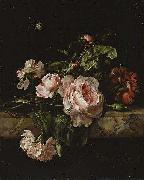 |
Willem van Aelst
|
|
(May 16, 1627 - in or after 1683) was a Dutch artist who specialized in still-life painting with flowers or game.
Van Aelst was born in Delft to a family of prominent city magistrates. He learned to paint from his uncle, the still-life painter Evert van Aelst. On 9 November 1643 he enrolled as a master of the Guild of Saint Luke at Delft.
Between 1645 and 1649 he lived in France. In 1649 Van Aelst travelled to Florence, where he served as court painter to Ferdinando II de' Medici, grand duke of Tuscany. At this time, the grand duke also employed two fellow Dutchmen Matthias Withoos and Otto Marseus van Schrieck, the latter also a still-life painter who probably influenced Van Aelst's style.
In 1656 he returned to the Netherlands to settle permanently in Amsterdam. He became one of the most prominent still-life painters of his generation, which allowed him to live on the Prinsengracht. He must have at Amsterdam died in 1683 or shortly thereafter, as his latest dated work is from that year. Van Aelst taught Rachel Ruysch and several others.
|
|
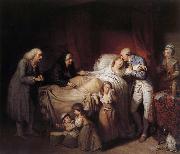 |
Wille Pierre Alexandre
|
|
French Painter , 1748--Paris 1821
Painter, son of Jean-Georges Wille. Between 1761 and 1763 he trained under Jean-Baptiste Greuze, who was a friend of his father, and later under Joseph-Marie Vien. Approved by the Acad?mie Royale in 1774, he devoted himself to painting sentimental genre scenes, such as the Last Moments of a Beloved Wife (1784; Cambrai, Mus. Mun.), in Greuze's manner. He also executed paintings for his father to engrave, including French Patriotism (1781) and the Double Reward of Merit (1785; both Bl?rancourt, Cheteau, Mus. N. Coop. Fr.-Amer.).
|
|
|
|
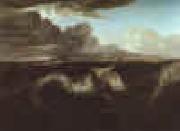 |
Washington Allston
|
|
1779-1843
Washington Allston Gallery Allston was born on a plantation on the Waccamaw River near Georgetown, South Carolina. His mother Rachel Moore had married Captain William Allston in 1775, though her husband died in 1781, shortly after the Battle of Cowpens. Moore remarried to Dr. Henry C. Flagg, the son of a wealthy shipping merchant from Newport, Rhode Island.
Allston graduated from Harvard College in 1800 and moved to Charleston, South Carolina for a short time before sailing to England in May 1801. He was admitted to the Royal Academy in London in September, when painter Benjamin West was then the president.
From 1803 to 1808 he visited the great museums of Paris and then for several years those of Italy, where he met Washington Irving in Rome, and Coleridge, his lifelong friend. In 1809 Allston married Ann Channing, sister of William Ellery Channing. Samuel F. B. Morse was one of Allston's art pupils and accompanied Allston to Europe in 1811. After traveling throughout western Europe, Allston finally settled in London, where he won fame and prizes for his pictures.
Allston was also a published writer. In London in 1813, he published The Sylphs of the Seasons, with Other Poems, republished in Boston, Massachusetts later that year. His wife died in February 1815, leaving him saddened, lonely, and homesick for America.
In 1818 he returned to the United States and lived in Cambridge, Massachusetts for 25 years. He was the uncle of the artists George Whiting Flagg and Jared Bradley Flagg, both of whom studied painting under him.
In 1841 he published Monaldi, a romance illustrating Italian life, and in 1850, a volume of his Lectures on Art, and Poems.
Allston died on July 9, 1843, at age 64. Allston is buried in Harvard Square, in "the Old Burying Ground" between the First Parish Church and Christ Church.
|
|
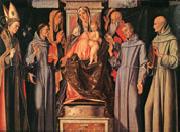 |
VIVARINI, Alvise
|
|
Italian Early Renaissance Painter ,
b. 1445/46, Venezia, d. 1503/5, Venezia
|
|
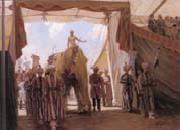 |
Victor C.Anderson
|
|
a well known Hudson River School painter,
American , 1882-1937
was an American painter and illustrator, primarily known for his rural life scenes and landscapes, whose works were featured in Life and other magazines of the early 20th Century, and who produced a wide range of illustrations for books as well as oil paintings. Like his father, Frank Anderson, Victor was a well-known painter of the Hudson River School. Victor drew and painted from an early age, eventually entering the Pratt Institute in Brooklyn. His favorite subjects were scenes of homespun rural life and landscapes of the late 19th and early 20th Centuries, and were popular nationally. For many years, he lived and had his studio at 195 Battle Avenue, White Plains, New York, where he died in 1937. He exhibited in the National Academy. His daughter, Joan Howe (1915-2005), was a well-known watercolor artist .
|
|
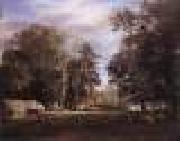 |
VELDE, Adriaen van de
|
|
Dutch Baroque Era Painter, 1636-1672
Dutch painter, draughtsman and etcher, son of Willem van de Velde I (see VELDE (ii), VAN DE, (1)). According to Houbraken, he first studied in Amsterdam with his father; however, unlike his father and his brother, Willem van de Velde II, Adriaen did not incline towards marine painting, so he was sent to Haarlem to complete his training with the landscape painter Jan Wijnants. By 1657 Adriaen had settled in Amsterdam, where various documents regularly record his presence until his death. During a career of less than two decades, van de Velde produced an extensive and varied body of paintings, drawings and prints.
|
|
|
|
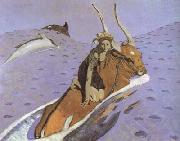 |
Valentin Aleksandrovich Serov
|
|
Russian Painter, 1865-1911
Russian painter, graphic artist and stage designer. As a child he lived in St Petersburg, but he made frequent trips abroad. In 1874 he travelled to Paris with his mother and frequented the studio of the Russian Realist painter, Il'ya Repin. In 1875 the art patron Savva Mamontov invited Serov and his mother to settle at ABRAMTSEVO outside Moscow, where he again had the opportunity to study under Repin and to meet other artists in the Mamontov circle. The Symbolist paintings of Mikhail Vrubel' and the late Impressionist landscapes and figure studies of Konstantin Korovin he saw at Abramtsevo had a lasting influence on the young Serov. From 1880 to 1885 he studied at the Academy of Art, St Petersburg, under Pavel Chistyakov (1832-1919). During the 1880s Serov also travelled abroad and became aware of French Impressionism. He began to use bright colours in portraits of figures seen in dappled sunlight and shade, as in his portrait of Vera Mamontov, Girl with Peaches (1887) and a portrait of Mariya Simonovich, Girl in Sunlight (1888; both Moscow, Tret'yakov Gal.).
|
|
|
|
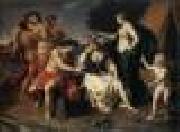 |
TURCHI, Alessandro
|
|
Italian Baroque Era Painter, 1578-1649
Italian painter. He first studied in Verona with Felice Brusasorci in whose studio he was recorded in 1597 (Brenzoni). Dal Pozzo reported that Turchi completed Brusasorci's Fall of the Manna (Verona, S Giorgio) after his master's death in 1605; his early Veronese paintings, such as the Adoration of the Shepherds (1608; Verona, S Fermo), are ambitious, with many figures and elaborate backgrounds, echoing the local tradition of which Paolo Veronese was the most distinguished exponent. Turchi may have gone to Venice with his fellow pupil, Marcantonio Bassetti, before moving to Rome c. 1614-15. He was paid for work in the Sala Regia of the Palazzo del Quirinale in 1616-17 (Briganti), where he collaborated with a team of artists, among them Giovanni Lanfranco and Carlo Saraceni. His part was to paint an oval medallion with the Gathering of the Manna (in situ) in a style that suggests Lanfranco's influence. He soon found patrons for altarpieces and cabinet paintings, among them Cardinal Scipione Borghese. By 1619 he had settled permanently in Rome and was a member of the Accademia di S Luca,
|
|
|
|
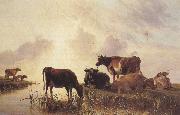 |
Thomas sidney cooper,R.A.
|
|
1803-1902
English painter. He was encouraged in his ambition to become an artist by Sir Thomas Lawrence and the animal painter Abraham Cooper (no relation; 1787-1868). He entered the Royal Academy Schools, London, in 1823. He subsequently taught art in Brussels where he met Eugene Verboeckhoven, whose work had a profound influence on him. Through Verboeckhoven he came to appreciate the work of such 17th-century Dutch painters as Aelbert Cuyp and Paulus Potter. In 1831 he returned to London, exhibiting at the Royal Society of British Artists. He exhibited 48 pictures at the British Institution between 1833 and 1863. The majority of his work was, however, exhibited at the Royal Academy; from 1833 to 1902 he exhibited 266 works there without a break,
|
|
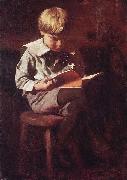 |
Thomas Pollock Anshutz
|
|
(1851-1912) was an American painter and teacher.
He studied art at the National Academy of Design in New York City, and moved to Philadelphia in 1875 to study under Thomas Eakins at the Philadelphia Sketch Club. He entered the Pennsylvania Academy of the Fine Arts in 1876, becoming Eakins's assistant there in 1878, and his successor in 1886. He later studied in Paris at the Academie Julian, 1892-93
|
|
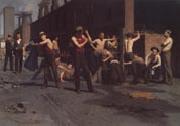 |
Thomas Anshutz
|
|
American Realist Painter,
1851-1912
was an American painter and teacher. He studied art in Paris at the Academie Julian, and at the Pennsylvania Academy of the Fine Arts under Thomas Eakins. His most famous painting, The Ironworkers' Noontime (1880), depicts several workers on their break in the yard of a foundry. Painted near Wheeling, West Virginia, it is conceived in a naturalistic style similar to that of Eakins, although Eakins never painted industrial subjects.
|
|
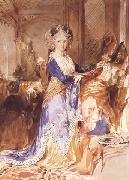 |
Thomas Allom
|
|
1804-1872
was an English artist, topographical illustrator and architect, and one of the founder members of what eventually became the Royal Institute of British Architects (RIBA).He was born in Lambeth, south London, the son of a coachman from Suffolk. In 1819, he was apprenticed to architect Francis Goodwin for whom he worked until 1826. He then studied at the Royal Academy School. His designs for churches shown at exhibitions in 1824 and 1827 aroused considerable interest, and he later designed many buildings in London (including a workhouse in Marloes Road, Kensington (1847), the Church of Christ in Highbury in 1850, the Church of St Peter's in Notting Hill in 1856, and the elegant Ladbroke Estate in west London). Further afield his works included workhouses at Calne, Wiltshire (1847) and in Liverpool, design of the William Brown Library also in Liverpool, (1857-1860), and the tower of St. Leodegarius Church, Basford near Nottingham (1860).
|
|
|
|
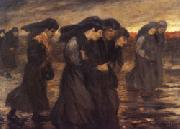 |
theophile-alexandre steinlen
|
|
Swiss-born French Art Nouveau Painter and Printmaker, 1859-1923
was a Swiss-born French Art Nouveau painter and printmaker. Born in Lausanne, Steinlen studied at the University of Lausanne before taking a job as a designer trainee at a textile mill in Mulhouse in eastern France. In his early twenties he was still developing his skills as a painter when he and his new wife were encouraged by the painter Francois Bocion to move to the artistic community in the Montmartre Quarter of Paris. Once there, Steinlen was befriended by the painter Adolphe Willette who introduced him the artistic crowd at Le Chat Noir that led to his commissions to do poster art for the cabaret owner/entertainer, Aristide Bruant and other commercial enterprises. La tournee du Chat Noir avec Rodolphe Salis (1896)In the early 1890s, Steinlen's paintings of rural landscapes, flowers, and nudes were being shown at the Salon des Independants. His 1895 lithograph titled Les Chanteurs des Rues was the frontispiece to a work entitled Chansons de Montmartre published by Editions Flammarion with sixteen original lithographs that illustrated the Belle Epoque songs of Paul Delmet. His permanent home, Montmartre and its environs was a favorite subject throughout Steinlen's life and he often painted scenes of some of the harsher aspects of life in the area. In addition to paintings and drawings, he also did sculpture on a limited basis, most notably figures of cats that he had great affection for as seen in many of his paintings. Steinlen became a regular contributor to Le Rire and Gil Blas magazines plus numerous other publications including L'Assiette au Beurre and Les Humouristes, a short-lived magazine he and a dozen other artists jointly founded in 1911.
|
|
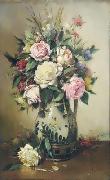 |
Theodor Aman
|
|
Theodor Aman (Romanian pronunciation: [teˈodor aˈman]; 20 March 1831, Câmpulung-Muscel-19 August 1891, Bucharest) was a Romanian painter of Armenian descent. His style is often considered to be a predecessor of Impressionism.
He is buried in Bellu cemetery.
|
|
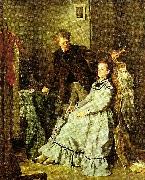 |
theodor alt
|
|
(Januar 1846 in Döhlau bei Hof (Oberfranken); 8. Oktober 1937 in Ansbach) war ein deutscher Maler.
Alt war der Sohn des Döhlauer Pastors Heinrich Alt und dessen Ehefrau Justina Ziegler. Nach erstem Unterricht durch seinen Vater besuchte Alt die Lateinschule in Regensburg, wo sein Vater von 1856 bis 1870 der evangelischen Gemeinde vorstand.
1861 wechselte er an die Kunstgewerbeschule N??rnberg, wo er als Schuler von Hans Ringlein bis 1863 blieb. Im Spatsommer desselben Jahres wechselte Alt mit Empfehlung seiner Lehrer an die Kunstakademie in M??nchen. Dort wurde er zuerst Sch??ler von Hermann Ansch??tz und in den Jahren 1866 bis 1873 bei Arthur von Ramberg.
|
|
|
|
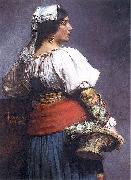 |
Teodor Axentowicz
|
|
born May 13, 1859 in Braşov, Romania - August 26, 1938 in Krakew) was a Polish-Armenian painter and university professor. A renowned artist of his times, he was also the rector of the Academy of Fine Arts in Krakew. As an artist, Axentowicz was famous for his portraits and subtle scenes of Hutsul life, set in the Carpathians.
Axentowicz was born May 13, 1859 in Braşov, Hungary (now Romania), to a family of Polish-Armenian ancestry. In 1893 in Chelsea, London, he married Iza Henrietta Gielgud, aunt of Val Gielgud and John [Arthur] Gielgud of the theatrical dynasty. A son, Philip S.A.D. Axentowicz was born in Chelsea in 1893.
Between 1879 and 1882 he studied at the Academy of Fine Arts in Munich. From there he moved to Paris, where he continued his education until 1895. During that time he started a long-time cooperation with various journals and started his career as a copyist, duplicating the works of Tizian and Botticelli. He also made numerous travels to London and Rome, where he prepared a set of portraits, one of the first in his career.
|
|
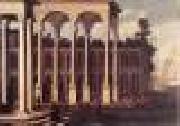 |
TASSI, Agostino
|
|
Italian painter, Roman school (b. 1578, Roma, d. 1644, Roma).
|
|
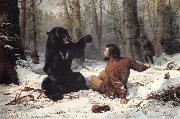 |
Tait Arthur Fitzwilliam
|
|
English-born American Painter, 1819-1905
American painter and lithographer of English birth. He spent the first three decades of his life in England and arrived in New York in 1850. Steeped in admiration for the subjects of Edwin Landseer and the style of the Pre-Raphaelites, he established himself as a realistic painter of animals and sporting scenes. For his images of Western hunters and trappers, he used as sources the works of George Catlin and William Ranney, artists who, unlike himself, had travelled extensively. He established a summer studio at a camp in the Adirondack Mountains, where he painted sporting scenes. These wilderness scenes, often composed around an anecdote, appealed to a wide popular audience, and from 1852 Currier & Ives as well as Louis Prang published a number of lithographs and chromolithographs of his work. Tait also composed still-lifes of game birds and, in his later career, barnyard scenes of sheep and chickens. His painting A Tight Fix: Bear Hunting in Early Winter
|
|
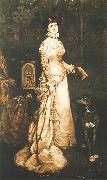 |
Tadeusz Ajdukiewicz
|
|
1852 in Wieliczka ?C January 9, 1916 in Krak??w) was a Polish painter.
From 1868 to 1873, he followed Władysław Luszczkiewicz classes in the Fine art school of Krakow. Later, he was in Vienna and Munich and in J??zef Brandt's atelier. In 1877, he travelled to Paris and Near East. In 1882, he lived in Vienna, where he worked for the aristocracy. In 1883, he went to London, where he made Prince of Wales' portrait. In 1884, to Constantinople, he was sultan Abdhulhamid II's guest. And he woked later in Sofia, Saint Petersburg and Bucharest. He joined the Polish Legions in 1914, during World War I, and he died in one of the battles of this war. He's first cousin was Zygmunt Ajdukiewicz.
|
|
 |
Tack Augustus Vincent
|
|
A painter of portraits, murals and abstractions.
American, 1870-1949
American, 1870-1949, was an American painter of portraits, landscapes and abstractions. He was born in Pittsburgh, Pennsylvania in 1870 and moved with his family to New York in 1883. After graduating from St. Francis Xavier College in New York City in 1890, Tack studied at the Art Students League of New York until 1895. He is believed to have frequented the studio of painter and stained glass designer John La Farge, whose portrait he painted around 1900. He had his first solo exhibition at the Kraushaar Galleries in New York City in 1896. The following year he moved to an artists?? colony in Deerfield, Massachusetts, where he met and later married Agnes Gordon Fuller, daughter of artist George Fuller. Tack maintained a studio in New York from 1894 until the end of his life. He had frequent exhibitions at New York City galleries. From 1900 until the 1920s his work was shown regularly at the Worcester Art Museum, at the Carnegie International exhibitions in Pittsburgh, and at the Pennsylvania Academy of the Fine Arts in Philadelphia. He taught at the Art Students League of New York between 1906 and 1910 and at Yale University from 1910 to 1913. About 1914 to 1915 his work attracted the notice of Duncan Phillips, who became his close friend and chief patron. Phillips and Tack also collaborated on the organization of the Allied War Salon of 1918. Tack died in 1949 in New York City.
|
|
|
|
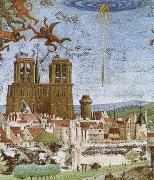 |
st ambrose
|
|
Milan; feast day December 7) Bishop of Milan. Raised in Rome, he became a Roman provincial governor. As a compromise candidate, he was unexpectedly elevated from unbaptized layman to bishop of Milan in 374. He established the medieval concept of the Christian emperor as subject to episcopal advice and censure when he forced the emperor Theodosius to seek forgiveness from the bishop, and he opposed tolerance for adherents of Arianism. He wrote theological treatises influenced by Greek philosophy, including On the Holy Spirit and On the Duties of Ministers, as well as a series of hymns. His brilliant sermons and personal example converted St. Augustine.
|
|
 |
Spinello Aretino
|
|
Italian Early Renaissance Painter, ca.1350-1410
was an Italian painter, the son of a Florentine named Luca, who had taken refuge in Arezzo in 1310 when exiled with the rest of the Ghibelline party. Spinello was a pupil of Jacopo del Casentino, a follower of Giotto, and his own style was a sort of link between the school of Giotto and that of Siena. In the early part of his life he worked in Florence as an assistant to his master Jacopo while painting frescoes in the church of the Carmine and in Santa Maria Novella. Between 1360 and 1384 he was occupied in painting many frescoes in and near Arezzo, almost all of which have now perished. After the sack of Arezzo in 1384 Spinello returned to Florence, and in 1387-1388 with some assistants covered the walls and vault of the sacristy of San Miniato of Florence with a series of frescoes, the chief of which represent scenes from the life of Saint Benedict. These still exist, though in a sadly restored condition; they are very Giotto-like in composition, but have some of the Siena decorative brilliance of color. In 1391-1392 Spinello was painting six frescoes, which still remain on the south wall of the Pisan Campo Santo, representing miracles of St. Potitus and St. Ephesus. For these he received 270 gold forms. Among his later works the chief are the very fine series of frescoes painted in 1407-1408 on the walls and vault of a chapel in the municipal buildings of Siena; these also have suffered much from repainting, but still are the finest of Spinello's existing frescoes. Sixteen of these represent the war of Frederick Barbarossa against the republic of Venice.
|
|
|
|
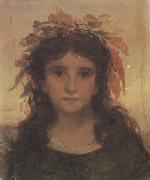 |
Sophie anderson
|
|
1823-1903
was a French-born British artist who specialised in genre painting of children and women, typically in rural settings. Her work is loosely associated with the Pre-Raphaelite movement. She was the daughter of Charles Gengembre, a Parisian architect, and his English wife. She was largely self-taught, but briefly studied portraiture with Charles de Steuben in Paris in 1843. The family left France for the United States to escape the 1848 revolution, They first lived in Cincinnati, Ohio, then in Manchester, Pennsylvania, where she met and married the British genre artist Walter Anderson. She initially worked in portraiture, including work for the chromolithographers Louis Prang & Co.. In 1854 the Andersons moved to London, where she exhibited her works in the Royal Academy. They returned to New York in 1858, then finally settled in London around 1863. Over the next three decades, her work was widely shown at venues including the Royal Academy, the Society of British Artists and many regional galleries.
|
|
|
|
|
|
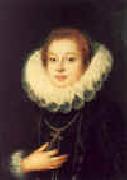 |
Sofonisba Anguissola
|
|
Italian
1532-1625
Sofonisba Anguissola was born in Cremona, Lombardy around 1532, the oldest of seven children, six of whom were daughters. Her father, Amilcare Anguissola, was a member of the Genoese minor nobility. Sofonisba's mother, Bianca Ponzone, was also of an affluent family of noble background. Her mother died when Sofonisba was four or five.
Over four generations, the Anguissola family had a strong connection to ancient Carthaginian history and they named their offspring after the great general Hannibal, thus the first daughter was named after the tragic Carthaginian figure Sophonisba.
Amilcare Anguissola encouraged all of his daughters (Sofonisba, Elena, Lucia, Europa, Minerva and Anna Maria) to cultivate and perfect their talents. Four of the sisters (Elena, Lucia, Europa and Anna Maria) became painters, but Sofonisba was by far the most accomplished and renowned. Elena became a nun (Sofonisba painted a portrait of her) and had to quit painting. Both Anna Maria and Europa gave up art upon marrying, while Lucia Anguissola, the best painter of Sophonisba's sisters, died young. The other sister, Minerva, became a writer and Latin scholar. Asdrubale, Sophonisba's brother, studied music and Latin but not painting.
Self-portrait, 1554Her aristocratic father made sure that Sofonisba and her sisters received a well-rounded education that included the fine arts. Anguissola was fourteen years old when her father sent her with her sister Elena to study with Bernardino Campi, a respected portrait and religious painter of the Lombard school, also from Cremona, Sofonisba's home town. When Campi moved to another city, Sofonisba continued her studies with the painter Bernardino Gatti (known as Il Sojaro). Sofonisba's apprenticeship with local painters set a precedent for women to be accepted as students of art.[citation needed] Dates are uncertain, but Anguissola probably continued her studies under Gatti for about three years(1551-1553).
Sophonisba's most important early work is Bernardino Campi Painting Sofonisba Anguissola (c 1550 Pinacoteca Nazionale, Siena). The double portrait depicts her art teacher in the act of painting a portrait of her.
In 1554, at age twenty-two, Sofonisba traveled to Rome, where she spent her time sketching various scenes and people. While in Rome, she met Michelangelo through the help of another painter who knew her work well. Meeting Michelangelo was a great honor for Sofonisba and she had the benefit of being informally trained by the great master.
Lucia, Minerva and Europa Anguissola Playing Chess, 1555. Museum Navrodwe, Poznan, Poland.When he made a request for her to draw a weeping boy, Sofonisba drew 'Child bitten by a crab' and sent it back to Michelangelo, who immediately recognized her talent (this sketch would continue to be discussed and copied for the next fifty years among artists and the aristocracy)
Michelangelo subsequently gave Anguissola sketches from his notebooks to draw in her own style and offered advice on the results. For at least two years Sofonisba continued this informal study, receiving substantial guidance from Michelangelo.
|
|
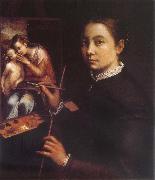 |
Sofonisba Anguisciola
|
|
1532?C1625, The best known of the sisters, she was trained, with Elena, by Campi and Gatti. Most of Vasari's account of his visit to the Anguissola family is devoted to Sofonisba, about whom he wrote: 'Anguissola has shown greater application and better grace than any other woman of our age in her endeavours at drawing; she has thus succeeded not only in drawing, colouring and painting from nature, and copying excellently from others, but by herself has created rare and very beautiful paintings'. Sofonisba's privileged background was unusual among woman artists of the 16th century, most of whom, like Lavinia Fontana (see FONTANA (ii),(2)), FEDE GALIZIA and Barbara Longhi (see LONGHI (i), (3)), were daughters of painters. Her social class did not, however, enable her to transcend the constraints of her sex. Without the possibility of studying anatomy, or drawing from life, she could not undertake the complex multi-figure compositions required for large-scale religious or history paintings. She turned instead to the models accessible to her, exploring a new type of portraiture with sitters in informal domestic settings. The influence of Campi, whose reputation was based on portraiture, is evident in her early works, such as the Self-portrait (Florence, Uffizi). Her work was allied to the worldly tradition of Cremona, much influenced by the art of Parma and Mantua, in which even religious works were imbued with extreme delicacy and charm. From Gatti she seems to have absorbed elements reminiscent of Correggio, beginning a trend that became marked in Cremonese painting of the late 16th century.
|
|
|
|
|
|
|
|
|
| Wholesale China Oil Painting Wholesale Oil Painting China Xiamen Portrait Reproduction on canvas Chinese Oil Painting Wholesale USA Oil Painting |
|
|
|
|
|